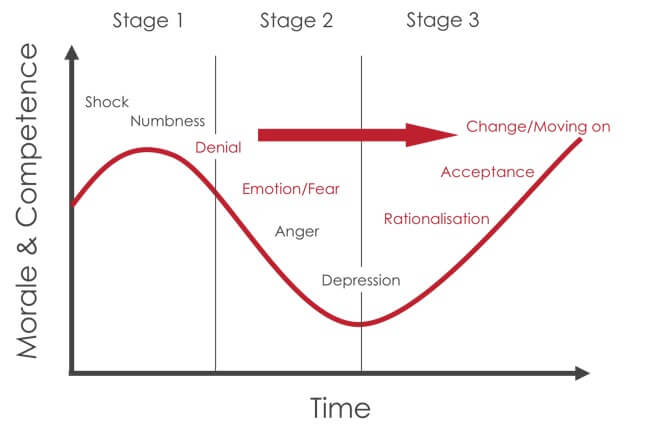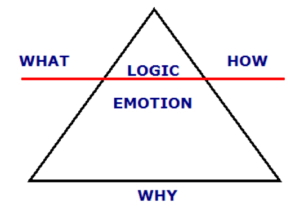
Most change programmes are poorly executed. FACT. Having delivered transformational change programmes for over two decades in all different shapes and sizes, I’ve seen first-hand the mess companies can get themselves into as they try and land new IT systems, new performance frameworks or even a new vision, values and culture into the workplace. Organisations who are most likely to be successful in landing change effectively are the ones that no longer view change as a discrete event to be managed, but as a constant opportunity to evolve. Read on for my six steps to landing change effectively.
Business growth is optional. Change is inevitable.
And constant change is the new business as usual.
Why most change programmes are not delivered effectively
Mckinsey state that 70% of change programmes fail to achieve their goals, primarily due to employee resistance and lack of management support. Which means when people are genuinely invested in change, it is 30% more likely to stick.
And the challenge to be in the camp of the successful 30% starts right at the very beginning.
Imagine the following scenerio…the senior leadership team are locked away in offices and meeting rooms literally spending hours individually and collectively debating the strategic direction of the business; what needs to change, what the longer-term time horizon of the company is, the vision, the aspirational goals, the culture, the systems required to execute it, and the people needed to deliver it. You name it; the ‘change’ is discussed and debated from every angle.
Having spent this time discussing, debating, building the business case for change they have personally (knowingly or unknowingly) worked their way through the three stages of the change curve, and have done the ‘WHY we need to change’ to death.

Now, here is their fatal mistake.
By the time they come to communicate ‘the change programme’ with their people, the senior leadership team have shifted their mindset. They’re now moving forward into execution mode focused on the WHAT and the HOW, and this is happening at the precise point when they start engaging with their people who are hearing all this for the first time and are right at the beginning of their change curve. ‘This is what we’re doing guys, and this is how we’re doing it’ is the message that is relayed.
So, you can see how this could play out.
They do a relatively poor job of mobilising commitment because they haven’t afforded the same discussions or buy-in time that their people need. They’re starting to feel resistance, but they’re not sure why because in their mind it’s now a done deal. The options have been wayed up; critical decisions have been made, and we are set to go…execution mode again!
Little attention is paid to mapping the transition with their people, from the current state reality to the desired end state, which effectively brings their people with them on the journey. They instead jump straight into implementation and wanting to realise the benefits. The resistance levels from their people have gone up another notch.
Is it any wonder change doesn’t land effectively?
And you know what, it doesn’t have to be this way.
You can create a consistent, repeatable, approach to change, ensuring you take your people with you on the journey.
But a word of warning. There are two pre-requisites to making it work.
Inspirational Leadership is a critical component of any change programme
The first is having in place inspirational leaders who have honed their leadership capability. Individuals who can translate positive intentions into tangible results. It’s about dreaming and then working out a plan and then working that plan to get to the dream. It’s an Attitude of ACTION.
Disciplined Execution is a given in any change programme
The Second is Disciplined Execution and creating consistency of action and consistency over time. This is the difference that makes the difference. You can spend eternity creating the best strategy and plan; however, you fall on disciplined execution.
Six steps to landing change effectively
#1 Develop a compelling business case
The change usually will originate from a response to a threat or a movement toward an opportunity, either internally or externally. But whatever the trigger, the reason for the change must be articulated in a way that motivates others to support the initiative.
While it might seem obvious to the CEO, COO or IT manager why the change needs to happen, this must be translated so your people, those individuals who are usually most removed from the decision-making process BUT most impacted by the change can make sense of it.
#2 Create a shared vision
A critical part of the leadership team’s role will be that of Chief Storyteller, to connect your people with the ‘change’ story and the vision and purpose for the business. Express the future in such a way so that it creates a positive picture of what the change will look like. You want your people to understand what they will be doing differently when the change is implemented.
In doing so, you create meaning to what they will do and how they will do it so they can find their compelling reason to feel inspired, energised, and motivated to deliver their best work.

#3 Mobilise commitment
Gaining commitment to the change starts with building and communicating a compelling WHY.
You can’t motivate someone to do something they don’t want to do. Yes, you can exert influence, pressure or power but for them to truly commit, they need to want to do it. After all, it’s all about the WIFM factor – what’s in it for me?
Let me share with you the WHY Triangle; the WHY being at the base, the WHAT on the left side and the HOW on the right.

Now add a horizontal line two-thirds of the way up your triangle with the word logic above the line and the word emotion below the line.

You see emotion is far more important than logic. Therefore when we communicate change, we must appeal to the emotions.
I like to think of it as a pendulum swinging from side to side. Logic one side and emotion on the other. When explaining a particular point, use facts and figures to trigger the logic, then tell a story or paint a picture to tap into the emotion. You can use the process in reverse, tell a story and then explain the logic or facts and figures.
But the point is simply this.
It’s the emotion that creates the motion – moving the individual into action!
#4 Map the change transition
This is all about mapping the current state reality, the desired end state and the transitional checkpoints in-between. Let me use a simple analogy to bring this to life.
You’re on the London underground at South Kensington (your current state reality), and you want to get to Kings Cross (your desired end state).

You have several routes and options to get you to Kings Cross, so your first decision is, which is the best route for me? Factors at play here could include time and speed of arrival, convenience (number of changes), preferred route, opinions of others.
You decide to take the Piccadilly line, a direct line with eight stops to Kings Cross. While on the tube you continually check each stop as you come into the station (it’s a habit we all do it!) and listen to the conductor as he or she announces the next station. These check-ins reassure you that you are on the right train to Kings Cross, and happily, with no surprises, you arrive at your destination.
Of course implementing a new IT platform is fundamentally more challenging than getting the tube across London (maybe not if its rush hour!) but the point is the same; know your beginning, know your end, know and map out your route and create your checks and measures to check your progress along the way.
#5 Implement the change
This comes back to the pre-requisites of inspirational leaders and disciplined execution. Plus, there will be a requirement to reinforce the business case continually, stay anchored to the compelling shared vision, and communicate, communicate and communicate the WHY, the WHAT and the HOW.
#6 Sustain the gain
It isn’t enough to implement change; the challenge is to keep driving forward, to shift old mindsets and behaviours in favour of new, to replace old ways of working with new and improved ones, and to keep the vision for change alive. Set yourself and your people up for success, both personally and professionally, and confront the reality that change is viewed as a constant.
‘The quality of your life is often in direct proportion to the amount of uncertainty and change which you can comfortably live with” – Tony Robbins.


